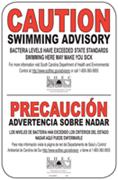South Carolina lakes and rivers are great places to cool off and relax with friends and family. As with any outdoor activity, you should always be safe when swimming in natural waters. Some of the rivers and streams in South Carolina have swimming advisories, letting you know that swimming there may make you sick.
Tips for Safe Swimming
- Be aware of swimming advisory signs.
- Do not go swimming or rafting during a storm or right after it rains.
- Avoid swallowing river, stream or lake water.
- Never swim alone. Always bring somebody with you.
- Avoid swimming in still, warm or muddy water.
- Never dive into shallow water or where you cannot see the bottom.
- Never use alcohol or drugs while swimming or boating.
- Never swim with deep cuts or wounds.
- Hold your nose if jumping or diving into natural water.
 What are Swimming Advisories?
What are Swimming Advisories?
The South Carolina Department of Health and Environmental Control (DHEC) tests rivers, lakes and streams all over the State. Sometimes these tests show high amounts of bacteria for some of our streams and rivers. DHEC puts up a swimming advisory sign where high amounts of bacteria have been found and people commonly swim.
Advisories are cautions that water may contain harmful germs. Since natural waters change so often, DHEC can only make general statements about the health risks of swimming in them; we cannot say exactly what the water is like at any particular time.
How Could I Get Sick?
Although water quality in South Carolina is generally good, DHEC can't guarantee that you won't get sick from swimming in a local swimming hole. There is always a potential risk when swimming in natural waters.
However, there is a greater chance of getting sick in waters with more bacteria. You might get sick by swallowing the water or putting your head under water. Most bacteria will not harm you but disease-causing germs are more likely to live where there is more bacteria.
Stay Safe
While you cannot always protect yourself from getting sick while swimming, you can be aware of advisories and choose not to swim in those areas. If you do decide to swim, don't swallow the water. It may also be good to avoid swimming in warm, still waters or swimming too soon after it rains.
Water Safety Links
Links to non-DHEC organizations found at this site are provided solely as a service to our users. The links do not constitute an endorsement of these organizations or their programs. DHEC is not responsible for the content of the individual organization web pages found at these links.
- US Army Corps of Engineers National Water Safety Program
- Safe Passage Water Safety Program
- American Red Cross Health & Safety Tips
- Centers for Disease Control Healthy Swimming
- National Safety Council
Permitted Natural Swimming Areas
A Natural Swimming Area is defined as an area where there is a fee or membership required to gain access to a natural freshwater location where swimming is promoted, or a natural freshwater location where improvements have been made to promote swimming. Natural Swimming Areas are required to take two water samples per month during the swimming season. These samples are analyzed for E. Coli. If the sample is greater than 349 colonies/100 ml, the area must be closed until a satisfactory sample is taken. Natural Swimming Areas are issued annual permits based on pre-season bacteriological samples.
Program Contact
- Luke Abel - (803) 898-4255